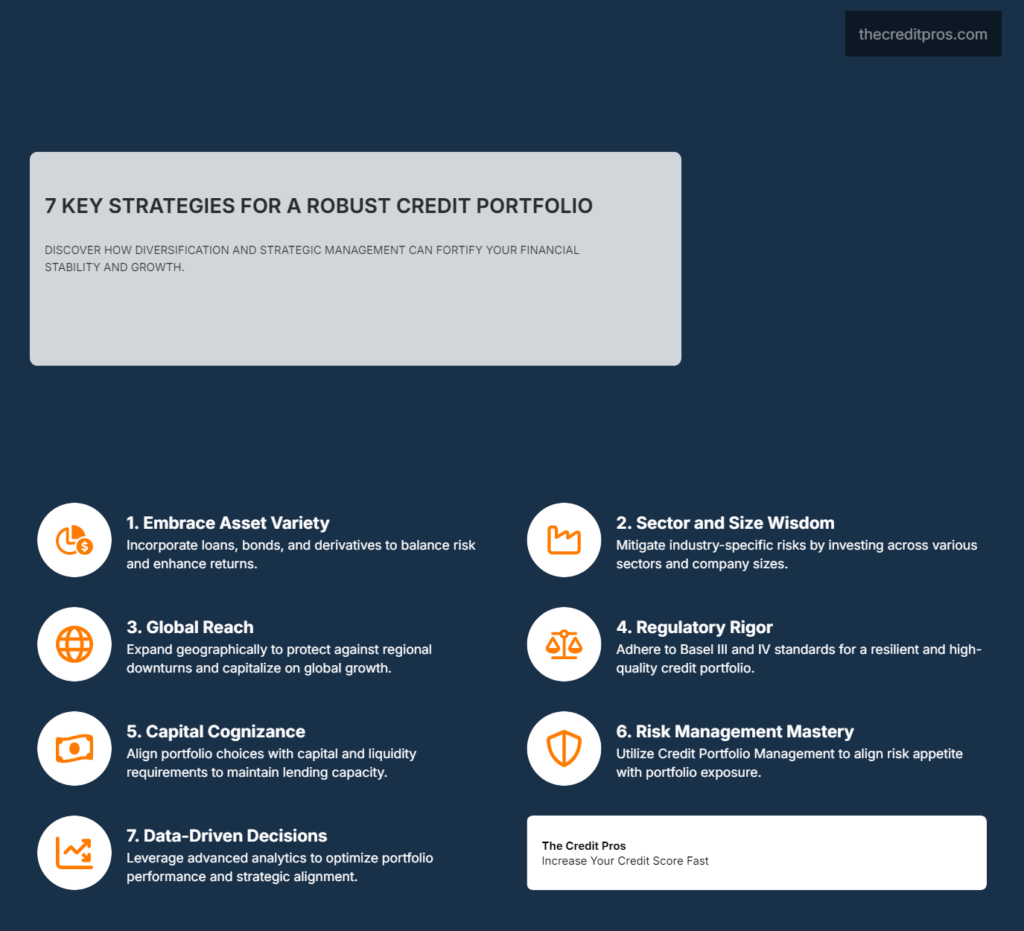Tabla de contenido
Understanding the nuances of a diverse credit portfolio can be a significant advantage in today’s complex financial markets. Why does diversification matter, and how can different types of credit exposures such as loans, bonds, and derivatives contribute to financial stability and improved credit scores? These questions are at the heart of our exploration. By examining the intricate details of portfolio diversity, we can uncover strategies that mitigate risks and enhance potential returns.
As we navigate through the layers of credit portfolio management, we’ll consider how regulatory frameworks like Basel III and IV influence financial decisions and the structuring of portfolios. What are the real benefits of spreading investments across various sectors, sizes, and geographical locations? This discussion aims to provide you with a clearer understanding of how diversified credit investments can serve as a robust foundation for both immediate financial health and long-term strategic growth.
Exploring the Diversity of Credit Portfolios: Loans, Bonds, and Derivatives
A diverse credit portfolio encompasses a range of financial instruments, each tailored to specific risk-return profiles. Préstamos, including personal, mortgage, or corporate loans, are fundamental, offering predictable returns through interest payments, albeit with varying risk levels depending on the borrower’s creditworthiness.
Bonds, whether government or corporate, typically provide a safer investment avenue compared to stocks, yielding fixed income throughout the bond’s duration. Derivatives, such as futures, options, and swaps, present a more complex landscape, utilized for hedging risks or speculative purposes. The strategic amalgamation of these instruments within a portfolio facilitates effective risk management and diversification.
The Importance of Sector and Size Variability in Diverse Credit Portfolios
Diversifying across different sectors and corporate sizes is crucial for mitigating industry-specific risks and leveraging growth across diverse economic sectors. For instance, the technology sector may offer high growth potential but also comes with notable volatility. Conversely, sectors like utilities or consumer staples provide stability, though they might yield lower growth opportunities. Including a mix of sectors helps balance the portfolio’s risk and return dynamics.
Similarly, diversifying across various corporate sizes, from large-cap to small-cap companies, enhances potential returns. Large-cap companies typically offer stability and regular dividends, while small-cap companies, though riskier, may yield higher growth potential.
Geographical Diversification: Expanding Internationally to Mitigate Risks
Incorporating international exposure into a credit portfolio can safeguard against regional economic downturns and tap into growth in emerging markets. For example, while the U.S. market might be experiencing slow growth, emerging markets in Asia or Africa could be witnessing rapid expansion. This form of diversification not only spreads risk but also opens new avenues for yield enhancement.
Navigating Regulatory and Financial Frameworks: Basel III and IV
Regulatory frameworks like Basel III y Basel IV play a significant role in shaping how banks and financial institutions manage their credit portfolios. These regulations enforce stricter capital requirements and liquidity ratios, prompting institutions to maintain higher quality credit portfolios. Basel III, focusing on high-quality liquid assets, ensures that institutions are resilient during financial stress, influencing portfolio composition towards more stable, less risky assets.
The Impact of Capital and Liquidity Requirements on Credit Portfolios
Capital and liquidity requirements dictate the amount of capital banks must hold against their assets, influencing their lending and investment capacities. Higher capital requirements often lead to more conservative portfolio choices, while stringent liquidity requirements ensure that institutions can meet short-term obligations. This regulatory environment compels institutions to meticulously balance their portfolios to meet these requirements while striving to maximize returns.

The Strategic Role of Credit Portfolio Management (CPM) in Risk Management
Credit Portfolio Management (CPM) is pivotal in aligning the credit portfolio with the institution’s risk appetite and regulatory demands. Effective CPM involves not only assessing individual credit risks but also managing the portfolio’s aggregate risk exposure. This comprehensive approach aids institutions in optimizing their credit portfolios, ensuring compliance with regulatory standards and alignment with strategic financial goals.
The Strategic Benefits of Credit Diversity
Mitigating Risks Through Diversification
Diversification is a key risk management strategy that alleviates concentration risk—the risk of substantial losses from having a large portion of exposures concentrated in a particular asset, sector, or region. By spreading investments across various asset classes, sectors, and geographies, a diverse credit portfolio diminishes the potential impact of a single adverse event, leading to more stable returns over time.
Enhancing Return on Equity Through Diverse Credit Portfolios
A well-diversified credit portfolio can boost return on equity by optimizing the risk-return trade-off. By selecting a mix of high-risk and low-risk assets, institutions can achieve a balance that maximizes returns while keeping risk within acceptable limits. This strategic allocation is crucial in financial planning and corporate finance, contributing to overall financial stability and growth.
The Indirect Effects of Portfolio Diversity on Credit Scores
For individuals and corporations, maintaining a diverse credit portfolio can positively influence puntajes de crédito. Credit diversity accounts for a portion of credit rating calculations, reflecting the individual’s or entity’s ability to manage different types of credit responsibly. This can lead to better loan terms, lower interest rates, and increased borrowing capacity, which are essential for financial health and expansion.
Challenges and Considerations in Building a Diverse Credit Portfolio
Analyzing Financial Implications: Cost and Margin Pressures
Constructing and maintaining a diverse credit portfolio involves significant costs and margin pressures. The expenses related to acquiring and managing a broad array of assets can be substantial. Additionally, the pursuit of diversification must be balanced against profit margins, as not all investments will contribute equally to the bottom line. Financial managers must carefully evaluate the cost-benefit ratio of diversification strategies to ensure they do not undermine profitability.
Influence of Market Conditions on Diversification Strategies
Market conditions significantly impact the feasibility and strategy of building a diverse credit portfolio. Factors such as market volatility, economic cycles, and access to international markets can either facilitate or impede diversification efforts. For instance, during a global economic downturn, the correlation between different asset classes might increase, diminishing the benefits of diversification.
The Need for Robust Data Management and Analytical Tools
Effective management of a diverse credit portfolio requires advanced data management systems and analytical tools. These systems assist in collecting, processing, and analyzing large volumes of complex financial data to make informed decisions. Robust IT infrastructure and analytical capabilities are essential for identifying trends, assessing risks, and optimizing the portfolio in alignment with strategic objectives.
Conclusion: The Strategic Imperative of Diversifying Your Credit Portfolio
Throughout this discussion, we have examined the multiple advantages of maintaining a diverse credit portfolio, which includes a variety of loans, bonds, and derivatives across different sectors, sizes, and geographies. This strategic diversification not only reduces risks but also enhances potential returns, ensuring financial stability and growth. By adhering to regulatory frameworks like Basel III and IV, financial institutions are encouraged to maintain high-quality, well-diversified portfolios that can endure economic fluctuations and sustain liquidity during financial stress.
Diversifying your credit exposures serves as a wise strategy to optimize your financial health and to broaden your growth opportunities. A well-rounded portfolio diminishes the impact of potential losses and improves credit scores, which are essential for securing favorable borrowing terms. As you consider your financial strategies, remember that a diverse credit portfolio serves to strategically position you for sustainable growth and resilience in a dynamic economic environment.




